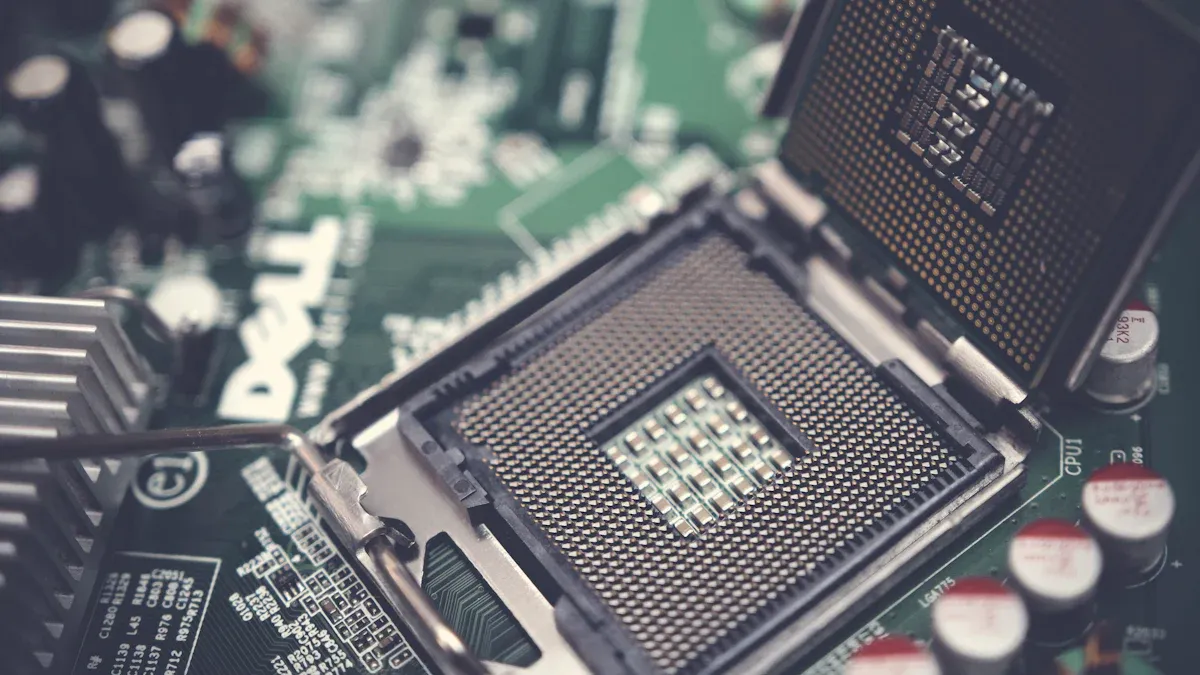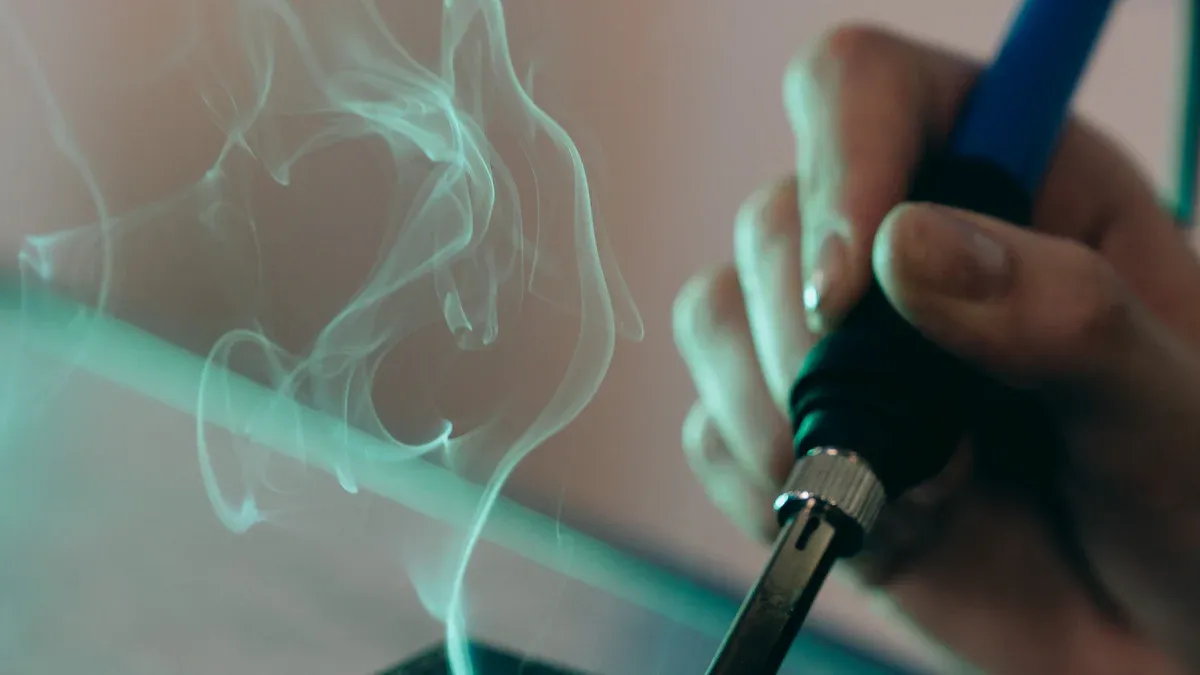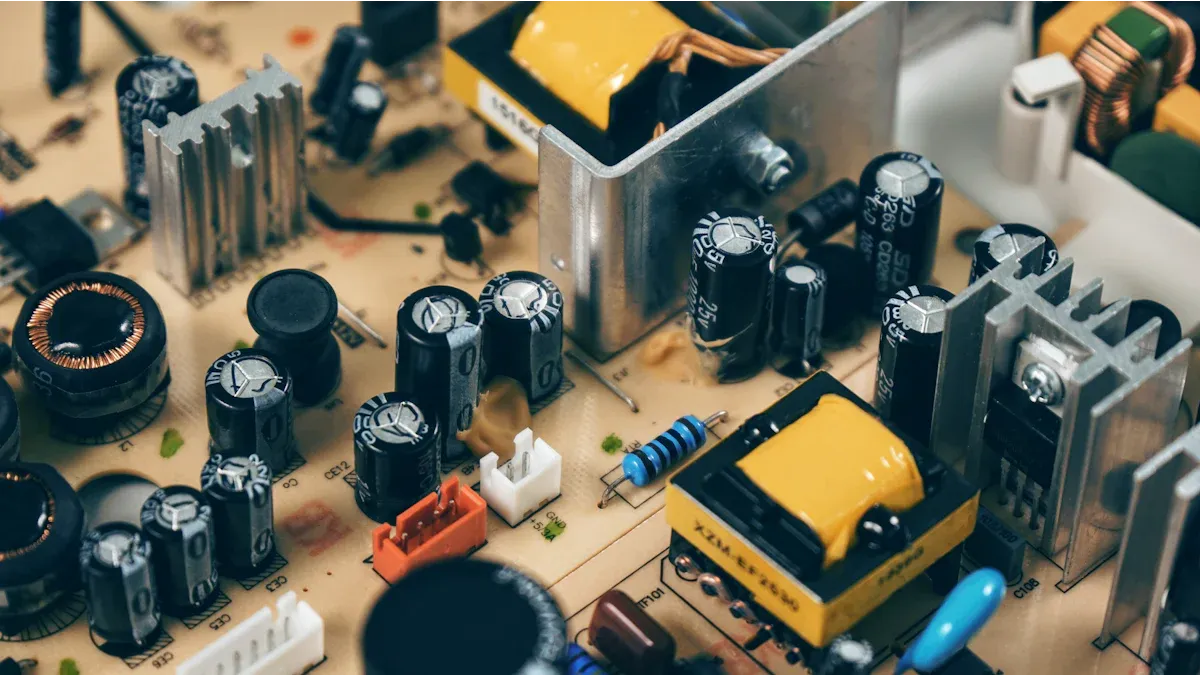
Low VOC conformal coating PCBA protects PCBAs from environmental damage. These coatings effectively block moisture, dust, and chemicals, ensuring PCBAs operate efficiently. By releasing fewer harmful VOCs, they contribute to cleaner air and create safer workplaces for individuals. Utilizing low VOC conformal coating PCBA not only benefits the planet but also promotes the health of workers, all while maintaining the performance of PCBAs.
Key Takeaways
Low VOC coatings shield PCBAs from water, dirt, and chemicals. This helps them work better and last longer.
These coatings are safer for people and nature. They release fewer bad chemicals and follow strict rules.
Using low VOC coatings can save money over time. They cut energy use and need less upkeep.
They are easy to apply in different ways. This makes them useful in many factories.
Switching to low VOC coatings can improve your brand’s reputation. It also supports eco-friendly goals and attracts green-minded buyers.
Understanding Low VOC Conformal Coatings

What are low VOC conformal coatings?
Low VOC conformal coatings are special materials that protect PCBAs. They shield PCBAs from things like water, dust, and chemicals. Unlike older coatings, they release fewer harmful VOCs when used. This makes them safer for people and better for the environment.
These coatings are common in industries that care about the planet. They also meet strict rules like RoHS and REACH standards. For example, these rules limit harmful substances in materials. The U.S. EPA also lowered VOC limits, pushing companies to use low VOC coatings.
Key characteristics and properties
Low VOC conformal coatings have special features that protect PCBAs. They also help reduce harm to the environment. Here are some of their main features:
Property | Value |
|---|---|
Viscosity | 950 CPS (+/-100) |
Temperature Stability | -76°F/-60°C to 392°F/200°C |
Dielectric Strength | 720 volts/mil |
These coatings work well in very hot or cold temperatures. They also provide strong insulation to stop electrical problems.
Low VOC coatings can be applied in different ways, like spraying or brushing. This flexibility helps manufacturers pick the best method for their needs.
How they differ from traditional conformal coatings
Low VOC coatings are better for the environment than older coatings. Older coatings have more VOCs, which pollute the air and harm workers. Low VOC coatings follow rules like REACH and RoHS, which limit harmful chemicals.
They also support eco-friendly manufacturing goals, like China’s plan to cut VOCs. Using these coatings lowers emissions and makes workplaces safer.
Low VOC coatings need less ventilation when applied, making setup easier. They also dry faster, speeding up production. While older coatings may seem cheaper, low VOC coatings save money in the long run. They meet rules and protect workers’ health, making them a smart choice.
Benefits of Low VOC Conformal Coating PCBA Applications

Environmental benefits, including reduced emissions and compliance with regulations
Switching to low VOC conformal coatings lowers harmful emissions during production. These coatings release fewer VOCs, improving air quality and helping the environment. Many industries now use low VOC coatings due to stricter rules and a focus on sustainability.
Evidence Description | Type of Evidence |
|---|---|
Demand for coatings with fewer VOC emissions is rising. | Market Trend |
Strict environmental rules push industries toward low-VOC coatings. | Regulatory Impact |
Focus on eco-friendly coatings with fewer VOCs is growing. | Environmental Focus |
Using low VOC coatings helps meet global standards like RoHS and REACH. These rules limit harmful substances in electronics. Adopting these coatings also supports goals like China’s VOC reduction plans, showing care for the planet.
Health and safety advantages for workers and end-users
Low VOC coatings make workplaces safer by reducing exposure to harmful chemicals. Older coatings release more VOCs, which can cause breathing problems and other health issues. Low VOC coatings lower these risks, protecting workers during use and drying.
A Taiwanese PCB company saw 40% fewer workplace hazards after switching to UV-curable low-VOC coatings.
The healthcare industry values low-VOC coatings for reducing toxic gas risks during sterilization.
OSHA noted a 22% increase in chemical exposure incidents in 2021, showing the dangers of older coatings.
For users, low VOC coatings make products safer. They stop harmful gases from being released, which is key for medical devices and electronics. Choosing low VOC coatings shows care for both workers and users.
Enhanced PCB performance and reliability
Low VOC coatings help the environment and health while improving PCB performance. They protect against water, dust, and chemicals, making PCBs last longer.
Metric | Silicone Coatings | Epoxy-based Coatings | Implication for PCB Endurance |
|---|---|---|---|
Thermal Stability | Better | Worse | Works well in extreme temperatures |
Elongation Rate | >200% | N/A | Handles PCB bending |
Dielectric Properties | < 3.0 at 1 MHz | N/A | Performs well in humid conditions |
Adhesion Loss after UV | 15% after 3,000h | 80% | Needs less maintenance in solar plants |
These coatings work well in tough conditions like high heat or humidity. Their strong thermal stability and insulation keep PCBs working under stress. Using low VOC coatings improves reliability and cuts maintenance costs over time.
Contribution to sustainable and efficient manufacturing.
Low VOC conformal coatings help make manufacturing greener and smarter. They reduce harm to the environment and improve production processes. Here’s how they support better manufacturing:
Eco-Friendly Material Choices: These coatings work well with green materials. Examples include halogen-free boards and bio-based inks. Such materials meet global rules like UL Ecologo and EPEAT. Using water-soluble solder pastes also cuts pollution and waste.
Improved Recycling Systems: Low VOC coatings make recycling PCBAs easier. Modular designs and no-glue connectors allow quick disassembly. This helps recover metals like gold and palladium. R2-certified recyclers sort and process materials efficiently. Chemicals can extract copper and tin, lowering recycling costs by 40%.
Energy Efficiency in Production: These coatings need less energy to dry. UV-curable coatings dry faster and at cooler temperatures. This saves energy and reduces costs. It also lowers the carbon footprint of production.
Cost Optimization Through Scale: Buying eco-friendly materials in bulk can save money. Low-temperature soldering also reduces energy use, cutting costs further. These steps make green manufacturing affordable.
Quantifying Hidden Benefits: Switching to low VOC coatings avoids fines from breaking rules like RoHS. Selling green products can improve your brand image. Studies show eco-friendly items often sell for 5-15% more.
Using low VOC coatings helps meet environmental goals and boosts efficiency. They save energy, improve recycling, and support sustainable manufacturing systems.
Comparing Low VOC Conformal Coatings to Traditional Coatings
VOC content and environmental impact
Low VOC coatings release fewer harmful chemicals into the air. This helps improve air quality and protects the environment. Traditional coatings have more VOCs, which pollute the air and harm workers’ health. Choosing low VOC coatings follows global rules like RoHS and REACH. These rules help reduce pollution and keep workplaces safer.
Low VOC coatings also support green manufacturing goals. For example, they align with China’s plans to cut VOC emissions. Using these coatings shows care for the planet and worker safety.
Application methods and ease of use
Low VOC coatings can be applied in many ways. You can spray, brush, or dip them onto surfaces. These methods make it easy to fit your needs. Traditional coatings need more equipment, like strong ventilation systems, to handle VOC fumes.
Low VOC coatings dry faster, speeding up production. Some types, like UV-curable coatings, dry at cooler temperatures. This saves energy and lowers costs. These features make low VOC coatings great for modern PCB assembly.
Cost-effectiveness and long-term value
Low VOC coatings save money over time. They cost about 30% less per 1000 ft² than traditional coatings. For example, low VOC coatings cost $101.03 per 1000 ft², while traditional ones cost $129.26. Removing the need for a washcoat cuts costs by 36%.
These coatings also reduce energy use and waste during curing. Their durability means fewer repairs and rejects, saving money. They protect PCBs from damage, making them last longer. Low VOC coatings are affordable and reliable, making them a smart choice for businesses.
Performance in tough conditions.
Low VOC conformal coatings protect PCBAs in extreme environments. They shield against high heat, cold, humidity, and chemicals. These coatings are great for aerospace and industrial uses. They keep PCBs working well under stress.
Temperature Resistance
Low VOC coatings stay strong in hot and cold temperatures. They work from -76°F (-60°C) to 392°F (200°C). This makes them perfect for cars and outdoor devices facing quick temperature changes.
Condition | Performance |
|---|---|
Extreme Cold | No cracks or peeling |
High Heat | Stays flexible and sticks well |
Humidity and Moisture Protection
Humidity can harm PCBAs by causing rust or short circuits. Low VOC coatings block water from getting inside. During 85°C/85% RH damp heat tests, they show strong protection and last a long time.
Tip: Use low VOC coatings for electronics near oceans or in wet climates to avoid water damage.
Chemical and Abrasion Resistance
Low VOC coatings resist damage from chemicals like fuel and cleaners. They are great for machines and medical tools. Their toughness also stops scratches, helping PCBAs last longer.
Real-World Validation
Tests prove these coatings work under real stress. For example, 1,000 thermal cycles from -40°C to 125°C check their durability. Vibration and bending tests show they stay effective under physical strain.
Low VOC coatings help PCBAs survive harsh conditions. They protect electronics, lower repair costs, and improve reliability.
Practical Tips for Using Low VOC Coatings on PCBAs
Ways to Apply Coatings and Tools to Use
Using low VOC coatings needs good planning for success. Pick a coating based on your PCB’s environment. Silicone coatings block water and chemicals. Urethane or epoxy coatings resist scratches and wear.
Choose the best way to apply the coating. Dipping is quick but needs a sealed setup to avoid messes. Brushing works well for small projects. Spraying covers large areas cheaply but needs careful masking. For big jobs, robots apply coatings evenly and avoid mistakes. Robots also keep coated and uncoated areas separate, making PCBs more reliable.
Eco-friendly tools are improving for low VOC coatings. New machines, like coating valves, work well with these coatings. They make applying coatings faster and more accurate. These tools are great for industries like healthcare and electronics.
Preparing Surfaces and Drying Coatings
Getting the surface ready is key for coatings to stick well. Clean the PCB to remove dirt, oils, and leftover flux. Use cleaning products that are safe for the environment. These cleaners work well but may take more time. Make sure the PCB is dry before adding the coating.
Drying the coating is important for full protection. Follow the maker’s instructions for drying time and heat. UV coatings dry fast under UV lights. Moisture-cure coatings need the right humidity levels. Use tools like ovens or UV lamps to dry coatings evenly.
Step | What to Do |
|---|---|
Cleaning | Remove dirt and oils with eco-friendly cleaning products. |
Drying | Make sure the PCB is dry in a clean space. |
Drying Process | Use the right tools and follow drying instructions. |
Matching Coatings with PCBA Materials
Low VOC coatings work with many PCBA materials. These include halogen-free boards and eco-friendly inks. These materials meet global rules like UL Ecologo and EPEAT, helping green manufacturing. Pick materials with good heat and strength properties for your needs.
For example, halogen-free FR-4 boards handle heat well and can be recycled. Water-based solder pastes cut waste and pollution. Eco-friendly inks are better for the planet than regular ones. Keeping a database of material features helps compare things like heat resistance and conductivity.
By using the right materials and methods, you can make PCBAs last longer and support eco-friendly goals.
Cost and return on investment.
Using low VOC conformal coatings saves money over time. The starting cost might be higher than older coatings, but the benefits are worth it. You can lower costs, meet rules, and make products last longer.
Material Certification and Bulk Savings
Eco-friendly materials like halogen-free FR-4 boards and bio-based inks have certifications like UL Ecologo and EPEAT. These prove they meet global standards. Buying these materials in bulk with industry partners lowers their cost. This makes green materials closer in price to regular ones.
Tip: Buying lead-free solder paste in bulk can make it as cheap as traditional options.
Energy and Process Efficiency
Low VOC coatings use less energy to dry. UV-curable coatings dry faster and at cooler temperatures. This saves energy and cuts costs. Using low-temperature soldering also reduces energy use.
Optimization | Cost Savings |
|---|---|
Low-Temperature Soldering | Saves 20% on energy costs |
UV-Curable Coatings | Shortens drying time by 50% |
Hidden Cost Benefits
Switching to low VOC coatings avoids fines for breaking rules like RoHS. This can save your business a lot of money. Green products also sell for more, boosting revenue by 5-15%.
Note: Studies show halogen-free materials cut end-of-life recycling costs by 60%.
Choosing low VOC coatings saves money and helps the planet. It also improves efficiency and makes your business stand out as eco-friendly.
Low VOC coatings are great for protecting PCBAs. They shield circuit boards from heat, water, and chemicals. This makes devices last longer and work better. These coatings also release fewer harmful VOCs, helping the environment and meeting global rules.
Feature | Benefit |
|---|---|
Protects Environment | Cuts down harmful gases and reduces air pollution. |
Safer for Workers | Lowers contact with dangerous chemicals during use. |
Better PCB Performance | Improves heat and electrical protection for long-lasting devices. |
Using low VOC coatings shows you care about the planet and quality. Try these coatings to meet green goals and improve safety and performance.
FAQ
What are VOCs, and why do they matter?
VOCs are chemicals that turn into gas during coating use. They pollute the air and can harm your health. Low VOC coatings release fewer gases, making air cleaner and workplaces safer.
How do you pick the right low VOC coating for your PCB?
Choose a coating based on where your PCB will be used. Silicone coatings block water and chemicals. Epoxy coatings are tough and long-lasting. Match the coating to your needs for the best protection.
Can low VOC coatings work with all PCBA materials?
Yes, they work with most eco-friendly materials like halogen-free boards. These materials follow rules like UL Ecologo and EPEAT, supporting green manufacturing.
Do low VOC coatings need special tools to apply?
No, you can use regular methods like spraying, brushing, or dipping. Robots can also apply them evenly, which is helpful for big projects.
How do low VOC coatings make PCBs more reliable?
They guard against water, chemicals, and extreme heat or cold. Tests like thermal cycling and damp heat checks prove they last. These coatings help PCBs work well in tough conditions.
See Also
Exploring Different Types and Fundamentals of PCBA Coatings
Improving Quality Assurance Practices in the PCBA Workflow
The Importance of Cleanliness in Ensuring PCBA Reliability
Defining PCBA Services and Their Importance in Electronics Production